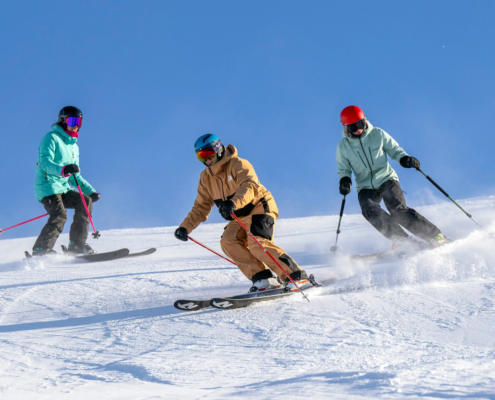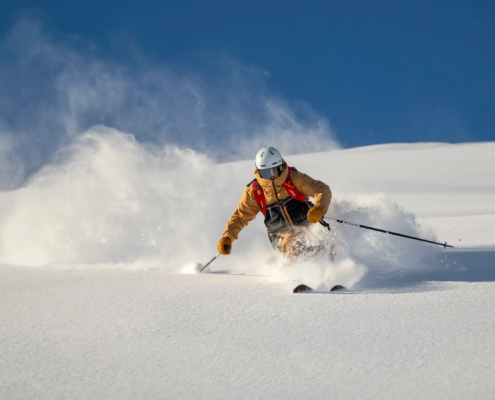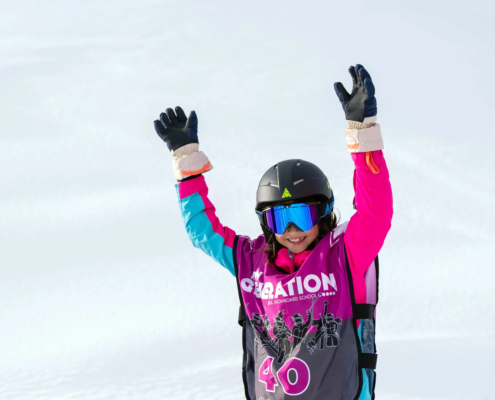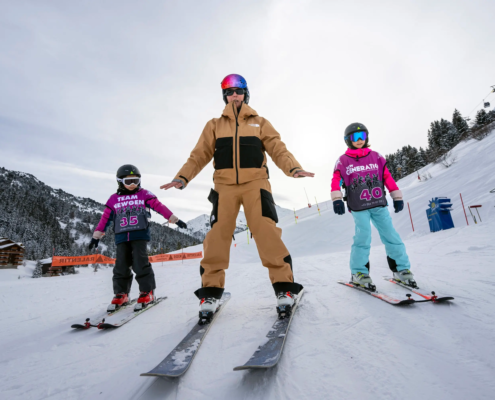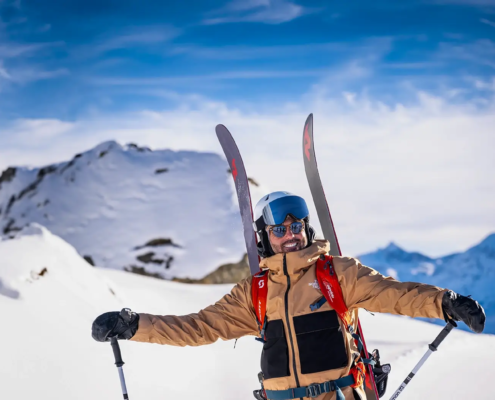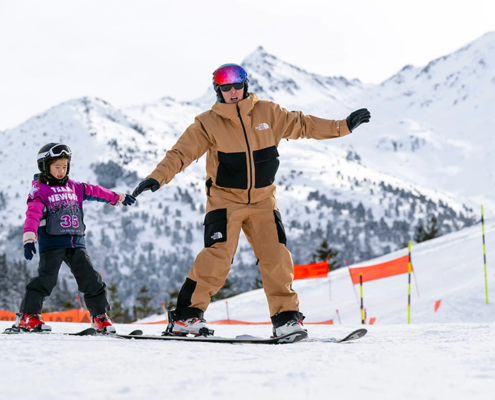How do I prepare for a ski holiday? As with any holiday, you need to do a little planning. However, we’ve compiled the key things to consider when planning your first ski trip. If you want even more detail, check out our in-depth guide on ski holiday planning.
What time of year to go skiing
Choosing the time of year to go skiing significantly impacts what type of holiday you’ll have. The ski season in Europe generally runs from early Dec through to late April. Here are the pros and cons of skiing in each month.
- Early December is a cost-effective option. Resorts offer discounted lift passes, and the slopes are generally quiet. However, you do run the risk of having little snowfall this time of year. It’s the time of year to head to a higher, more snow-sure resort.
- Christmas and New Year getaways are sometimes exactly what you need. And if you book into a catered chalet, you can have someone else basting the turkey and making you mince pies (more on that below). Christmas is usually quieter than New Year’s week, but both weeks are filled with many families taking advantage of school holidays. It can be a magical time in the mountains, though, with the snow and Christmas decorations, you genuinely feel like you’re in a winter wonderland.
- January is the time of year to ski if you’re looking for both a bargain and loads of snow. You’re likelier to have chilly days and less sunshine, but the snow is nearly guaranteed to be good this time of year. It’s a great time to learn to ski, as the snowpack is likely to be good, and the slopes are bound to be quiet. Plus you can often find New Year’s discounts on accommodation.
- February is peak season and probably the busiest month. With half-term holidaymakers hitting the slopes, prices shoot up as well. If you don’t have children, avoid these peak weeks with their high prices and busy pistes. However, if you sneak a week in early Feb or late Feb, you can miss the school holidays and still take advantage of great snow whilst the days are starting to get longer.
- March brings warmer weather and longer days. This is an excellent time of year for leisurely lunches and afternoon drinks on sun terraces. However, the snow is usually quite good, especially in the morning. The higher temperatures mean the afternoon snow can become slushy on lower pistes.
- Once April hits, it’s well and truly spring skiing. Expect long sunny days, slushy slopes and BBQs aplenty. The resort usually has a fun vibe, with many end-of-season parties and events. If the quality of the snow you ski isn’t a bother to you, but sunshine is, April is the time for you. The last few weeks of the season also often have discounts to make the most of.
We recommend learning to ski in January or March for beginners with school-age children. This way, you can take advantage of better deals and quieter pistes and be reasonably sure the snow will be good.
If your children are in school, be aware of the busyness of those peak weeks. Skiing with your children is a fantastic family experience and an activity you can enjoy together. Some of these blogs might be useful if you want to bring your little ones out.
What resort to go to?
Choosing the right resort for you can feel like a big task. Here are four aspects of resorts to research to find the best one for you.
Price – Ski resorts vary in cost. Some are budget-friendly, and others are more exclusive. Depending on your budget, do a Google search on how expensive that resort is. The cost of lift passes, food and accommodation will all be impacted.
Atmosphere – Are you looking to have a bit of a party and spend your afternoons après-skiing in the sunshine? Or are you looking for a quaint, traditional French village? Or perhaps you want somewhere with great kids’ activities and family-friendly restaurants.
Skiing – What is skiing like? Some cater to more advanced skiers, whereas others have more gentle terrain. You don’t want to show up for your first time skiing in a resort with few beginner-friendly slopes. Here’s a guide to some of the best ski resorts for beginners to help you.
Choose the correct type of accommodation.
Most ski resorts have a few different types of accommodation, depending on what you’re looking for. One of the critical things to look for – no matter what kind of accommodation you’ve – is where it is located within the village. For example, can you ski out from the front door? Or will you need to get a bus to the pistes? Some chalet companies will offer lifts around the resort if your chalet isn’t within walking distance to the slopes, but this is something to enquire about when booking.
Catered chalet – These are all-inclusive packages where you usually have a chef and host working in the chalet most days of the week. They cook breakfast and dinner and provide afternoon tea each day. This is an excellent option for those who want everything taken care of for them.
Shared chalets – Unless you book the whole chalet for your party, you’ll probably share with others. Most chalet guests are like-minded folk, making for a fun and sociable setting. Just be prepared to mix and dine with other parties.
Self-catered apartment or chalet – Alternatively, if you prefer the flexibility of choosing your meal times and opting for more meals out, self-catered options are becoming increasingly popular in resorts. Cook for yourself, eat when you want and have more space in your accommodation than a catered chalet.
Hotel – Hotels in ski resorts frequently are bed-and-breakfast with the option to eat in the hotel restaurant in the evening.
Airbnb – It’s becoming easier to find Airbnb in ski resorts. However, fewer than you’ll see in a city.
Ski Lessons, Ski Hire and Lift Passes
You’ll need to sort out three critical aspects of your ski holiday.
Ski Lessons – A quality ski lesson is crucial to a great first experience on skis. We recommend you book adult group ski lessons for your first time on skis.
Ski Hire – You will want to hire your ski equipment for your first time skiing. This includes ski boots, skis, and poles. You can also hire a helmet if you do not have your own. We recommend you book this in advance as you usually get a better rate if you do so.
We’ve partnered with three different ski hire companies across France, Switzerland and Austria. You can book your ski hire through us for an exclusive discount.
Lift Passes – You can organise your lift pass purchase before you come out on holiday or get it once you’re in the resort. Most chalet companies or hotels offer a small discount if you purchase your lift pass ahead of time through them.
Back to top

